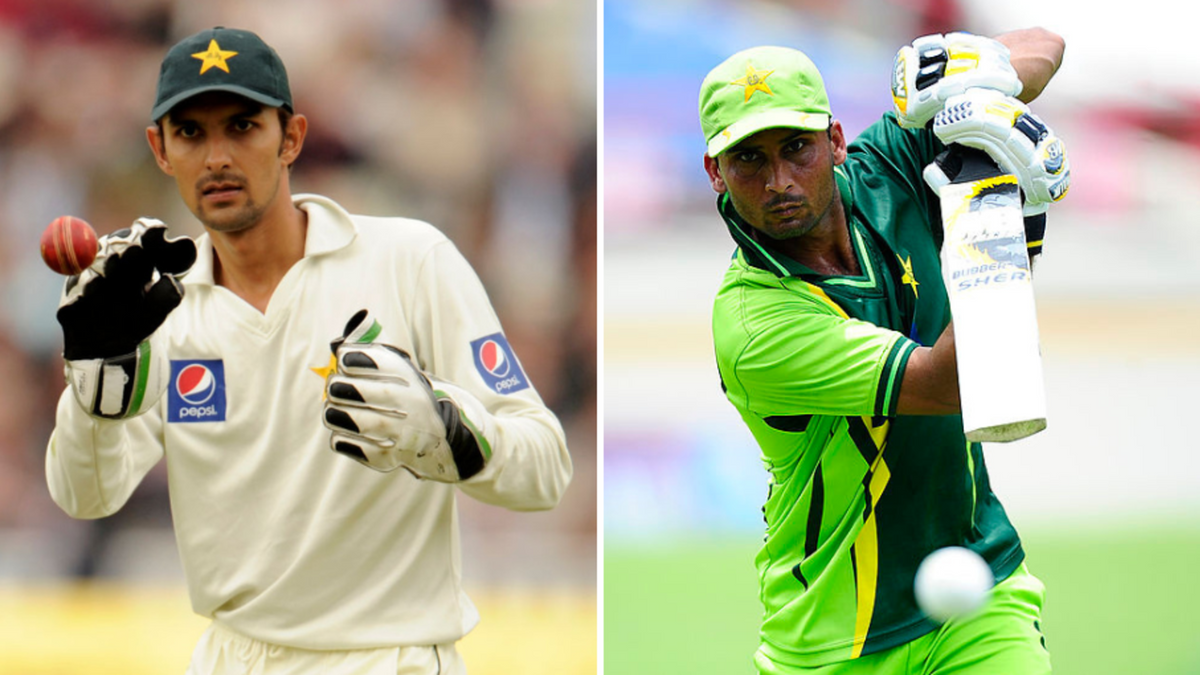
Pakistan’s wicketkeeping saga of the 21st century can be broken down into three distinct periods. The early 2000s were a continuation of the Moin Khan-Rashid Latif duopoly, after which came the Akmal brothers, one after another. The latest phase has been all about Sarfaraz Ahmed and Mohammad Rizwan.
Through the two decades, other names had popped up as well. Be it as a stop-gap arrangement for one of the unavailable first-choices, or a half-baked attempt to look into the future, a few wicketkeepers were tried and discarded.
Here is a look at their careers.
Atiq-uz-Zaman (2000)
1 Test, 26 runs @ 13.00; 5 Ct, 0 St
3 ODIs, 34 runs @ 17.00, 3 Ct, 1 St
One of the few names who tried to break the Moin-Latif reign, Atiq found a way in after a stellar domestic season in 2000/01, where he broke the record for the most wicketkeeping dismissals (76). A Test call-up followed, and he seemingly capitalised on Moin’s absence by claiming five catches. However, once Moin was back, Atiq did not get another Test cap.
Half a year later, he appeared in three ODIs, but could not latch on to a place. He continued to play domestic cricket until 2007 – including league cricket stints in England – before venturing into coaching.
Humayun Farhat (2001)
1 Test, 54 runs @ 27.00, 0 Ct, 0 St
5 ODIs, 60 runs @ 20.00; 4 Ct, 3 St
The brother of Imran, Humayun, too, suffered the Atiq fate, playing just one Test and a handful of ODIs before he was sidelined. The 2001 Hamilton Test was largely uneventful: at the time of writing this piece, Humayun is the only man to have kept wickets but not effected a dismissal in Test cricket. He did stand bravely against New Zealand’s raging pace attack, scoring 28 and 26 from No.7 in Pakistan’s totals of 104 and 118, but they were not enough for him to earn a second Test cap.
Moin’s injury allowed him to feature in the ODI tri-series that followed, but the five games were not enough for Humayun to properly settle in. Years later, he played in the ICL and went on to appear in domestic cricket until 2015.
Zulqarnain Haider (2007-2010)
1 Test, 88 runs @ 44.00, 1 fifty; 2 Ct, 0 St
4 ODIs, 48 runs @ 24.00; 1 Ct, 1 St
3 T20Is, 23 runs @ 7.66; 0 Ct, 1 St
A life worthy of being turned into a documentary, Zulqarnain ended up being a one-Test wonder, with a few limited-overs appearances scattered around. He broke in aged 20 following Kamran Akmal’s poor returns, featuring in a T20 against South Africa in 2007. Three years later, another chance came in the form of a Test debut. A first-ball duck in Pakistan’s total of 72 was an inauspicious start, but he turned things around quickly with a brave 88 in the second innings. A finger injury meant that he was out for the rest of the tour.
He played a few more white-ball games later that year, before a mysterious departure from the tour of UAE to England, where he took asylum, fearing for his safety from bookies. A PCB suspension followed, and by the end of 2010, Haider had announced his international retirement. And while he withdrew it months later, no more international caps were added.
Adnan Akmal (2010-2014)
21 Tests, 591 runs @ 24.62, 3 fifties; 66 Ct, 11 St
5 ODIs, 62 runs @ 20.66, 0 fifties; 3 Ct, 0 St
Arguably the least spoken-about (and controversial) of the Akmal brothers, Adnan was the best wicketkeeper of the family but probably the least proficient with bat. Nevertheless, he played more Test matches than everyone else combined on this list. There is an old tale that says both Kamran and Adnan were erroneously picked for a national camp in 2004, and Kamran eventually got the go-ahead. Adnan’s chance finally came when Zulqarnain disappeared in 2010, and he managed to play on and off for the next four years.
Three fifties, 66 catches and 11 stumpings later, Adnan lost his spot to Sarfaraz in 2014. His brief ODI career had already extinguished by then. While some would argue he does not belong on this list, having played a decent number of Tests, the fact that his Pakistan career whittled away at 29 does make him a what-could-have-been candidate.
Mohammad Salman (2011)
2 Tests, 25 runs @ 6.25; 2 Ct, 1 St
7 ODIs, 22 runs @ 11.00; 8 Ct, 2 St
1 T20I, 5 runs @ 5.00, 1 Ct, 1 St
For long, Salman was earmarked for greater honours, and did enough at the domestic level to warrant an international call-up. Drafted in for Pakistan’s 2011 tour of the Caribbean soon after the World Cup, he played five ODIs, a Test match and a T20I, but nothing quite stood out from those appearances. He got two more chances in the ODIs against Ireland that followed, but did not get a chance to bat at all. At the end of the exercise, Pakistan had gone back to the Akmal brothers. Salman’s domestic career, which began in 1998, wrapped up by 2016.
Shakeel Ansar (2012)
2 T20Is, 0 runs, 1 catch, 1 stumping
The least-capped player on the list, Shakeel earned his maiden chance at 33, fifteen years after his first-class debut, following a whirlwind ton in a domestic T20 league in 2012. He was promptly selected for a couple of T20Is in Sri Lanka in 2012. Nothing noteworthy came out of it, and Shakeel vanished just as quickly as he had arrived. By 2019, his cricketing career had seemingly come to a close.
Note: Younis Khan filled in as designated wicketkeeper in the absence of Moin Khan in two ODIs in 2004, and another in 2005. He took four catches.








